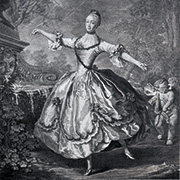Gluck’s duties in Vienna included the provision of “music for the ballets”. His own compositions and pasticci, independent works in their own right, are now being published as part of the Gluck Complete Works.
In the second half of the 18th century in the Vienna court theatres, ballets formed an essential component of each production: it was then common practice to perform one or more ballets as interludes between the acts of a play or opera. There was correspondingly a considerable need for suitable music, something which was to the benefit of Christoph Willibald Gluck who made his living as, amongst other things, “Compositor von der Music zu denen Balletten” at the Viennese court between 1759 and 1765. In this function he was responsible for the music for the ballets, music which, in line with contemporary practice, was not necessarily completely newly-composed by him. In fact, the creative process was much more about producing the requisite ballet music in collaboration with the choreographers, according to the available personnel and institutional resources, whilst taking into consideration the expectations of the public and the wishes of the patron (the Viennese court). Behind this lay a quite different understanding of the concepts of “work” and “author” than in other musical genres or other periods, and the Gluck Complete Works (GGA) takes this into account by publishing his ballet music in Volumes II/3–II/5 of the Complete Works.
The three part-volumes follow the chronology of the works according to their date of composition or first performance. The part-volume II/5, published at the end of 2016, contains the last compositions arranged chronologically from the entire period 1759 to 1765, namely the six pieces of ballet music composed in Vienna between 1760 and 1765: Les Aventures champêtres (premiere: 19.11.1760), Les Blanchisseuses (28.12.1760), Les Matelots (27.1.1761), La Halte des Calmouckes (23.3.1761), Le Tuteur dupé ou L’Amant statue (21.6.1761) and Achille in Sciro (planned for August 1765).
As the titles imply, these works belong to different genres. Les Blanchisseuses and Les Matelots are examples of the then-popular type of genre ballet – loose compilations of individual scenes, in which the everyday tasks of particular occupational groups (mainly of lower social standing) form the background, in atmosphere and visuals, for short love stories. Les Aventures champêtres is a pastoral ballet with cheerful genre scenes from the life of country farming folk, located in an Alsatian village. The note “Composè Sur des airs d’Opera comiques representés a Vienne” in the scenario indicates that this is a pasticcio ballet. In fact, it can be demonstrated that Gluck used popular song numbers for this ballet music from Opéras-comiques performed in Vienna, both from his own works (Le Diable à quatre, La Fausse Esclave, L’Île de Merlin and Cythère assiégée) as well as from operas by other composers (Raton et Rosette, Les Amours de Bastien et Bastienne and Ninette à la cour). In this piece the close interconnections between Opéra-comique and ballet at the time are shown in exemplary fashion.
Likewise, the influences of Italian theatrical traditions can be discerned: for the comic ballet Le Tuteur dupé ou L’Amant statue the choreographer Gasparo Angiolini, with whom Gluck worked so successfully during this period, used a subject and figures from the Italian Commedia dell’arte. By contrast, La Halte des Calmouckes is a variant of the form of “Turkish ballet” then very popular in Vienna: Angiolini places an ethnic-national group, the Kalmyks, at the centre of the ballet action, combining them in the public’s perception with a fascination for the exotic, and staging this highly effectively by visual, choreographic, and musical means. The heart of the music, the extended Allegretto No. 9, was later used by Gluck as “Air pour les esclaves” in Iphigénie en Aulide (II/3).
Gluck’s ballett Achille in Sciro was not performed during the composer’s lifetime: this large-scale, heroic-pantomimic action ballet was composed for the festivities at the wedding of Archduke Leopold and the Spanish Infanta Maria Luisa in 1765 in Innsbruck, which was interrupted on 18 August 1765 by the sudden death of the Emperor Francis I. At the same time this marked the end of Gluck’s activities as “Compositor” of ballet music for the Viennese court, which formed an important part of his output around 1760. These works have now been made available for the first time for research and practical use in a historical-critical edition.
Irene Brandenburg
(from [t]akte 2/2016)



